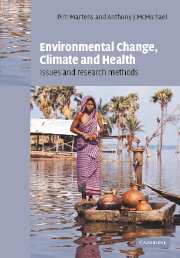Book contents
- Frontmatter
- Contents
- List of contributors
- Foreword
- 1 Global environmental changes: anticipating and assessing risks to health
- 2 Historical connections between climate, medical thought and human health
- 3 The contribution of global environmental factors to ill-health
- 4 Surprise, nonlinearity and complex behaviour
- 5 Epidemiological and impacts assessment methods
- 6 Retrospective studies: analogue approaches to describing climate variability and health
- 7 Detecting the infectious disease consequences of climate change and extreme weather events
- 8 Integrated Assessment modelling of human health impacts
- 9 Remote sensing, GIS and spatial statistics: powerful tools for landscape epidemiology
- 10 Monitoring the health impacts of global climate change
- 11 Epidemiology, environmental health and global change
- 12 Dealing with scientific uncertainties
- Index
- Plate section
- References
2 - Historical connections between climate, medical thought and human health
Published online by Cambridge University Press: 28 July 2009
- Frontmatter
- Contents
- List of contributors
- Foreword
- 1 Global environmental changes: anticipating and assessing risks to health
- 2 Historical connections between climate, medical thought and human health
- 3 The contribution of global environmental factors to ill-health
- 4 Surprise, nonlinearity and complex behaviour
- 5 Epidemiological and impacts assessment methods
- 6 Retrospective studies: analogue approaches to describing climate variability and health
- 7 Detecting the infectious disease consequences of climate change and extreme weather events
- 8 Integrated Assessment modelling of human health impacts
- 9 Remote sensing, GIS and spatial statistics: powerful tools for landscape epidemiology
- 10 Monitoring the health impacts of global climate change
- 11 Epidemiology, environmental health and global change
- 12 Dealing with scientific uncertainties
- Index
- Plate section
- References
Summary
Traditional Western environmental medicine acquired renewed significance during the 1990s. Significant global climate change is likely to occur during the twenty-first century, and will alter the needs for population health maintenance as well as the resources available for the management of disease crises. In the past, environmental medicine held that human health and disease could not be assessed independently of climate and place. Interactions between changing climate and human health were thus assumed. Those who hope to recover a measure of this more ancient stance towards medicine question the utility of framing future epidemiology in narrow clinical paradigms. Advocates of a more global epidemiology turn away from the study of risk factors and therapy, in favour of larger environmental models of health and disease.
The study of the history of disease and biometeorology during the last century carried the expansive environmental perspective far more than did clinical and community epidemiology. History can have relevance now for those crafting a new global epidemiological vision. Medicine's former interest in weather and climate directed investigation and intervention towards population health maintenance. Withdrawing from grand and costly goals, western medicine increasingly focused on individuals and local environmental hazards, even in the arena of public health. The heroes and often-told stories of medical history relayed by medical and scientific practitioners accentuate this narrowed perspective. By questioning accepted and self-congratulatory historical constructions of the past, epidemiologists excavate new foundations for the future.
- Type
- Chapter
- Information
- Environmental Change, Climate and HealthIssues and Research Methods, pp. 18 - 51Publisher: Cambridge University PressPrint publication year: 2002
References
- 2
- Cited by



